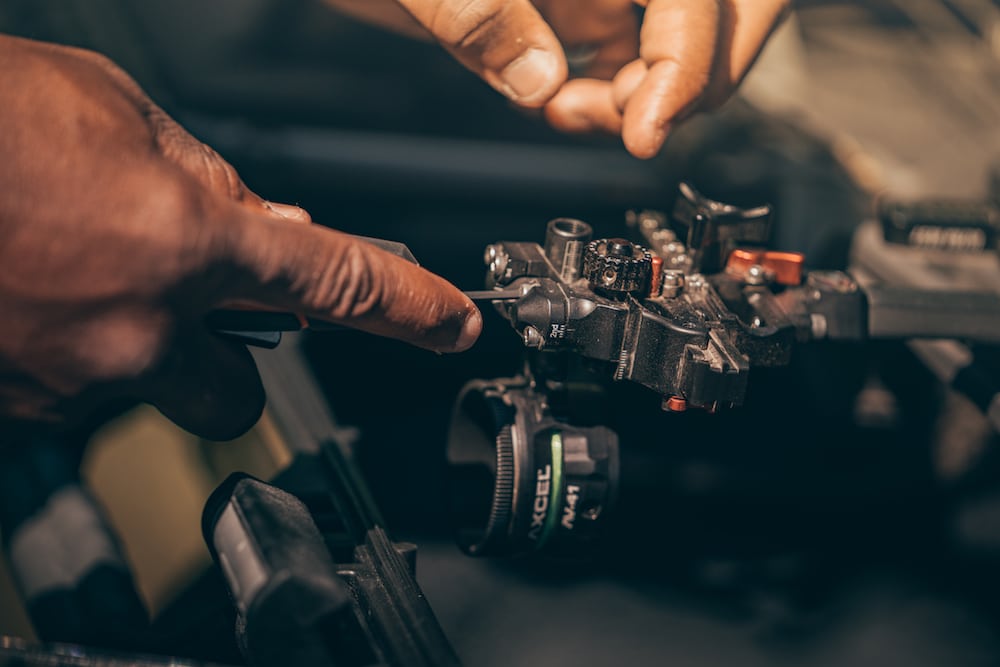It’s the second day of your annual weeklong bowhunting vacation when disaster strikes. Even though you checked your bow repeatedly before leaving home, something went wrong. A string nicked by a broadhead, an errant screw backing out of your rest or sight, or worse — the unfortunate possibilities are endless. Fortunately, saving your hunt from its demise is something you can control. You just need access to the proper gear in your field repair kit.

You should have replacements for any major equipment components and a multitool. Photo Credit: Bowhunters United
Think of your field repair kit as a first-aid toolbox designed to keep your bow operational, no matter the circumstances. Compound bows are complex tools, harnessed together by strings and cables. When properly tuned, they launch arrows downrange with incredible accuracy. Sight, rest, quiver, and all, the system is capable of repeatable accuracy shot after shot. But the tight groups you proudly snapped many a cellphone picture of to post on your Instagram stories all summer long can quickly open up when something is out of whack. This is where your repair kit and the tools inside become critical to save your hunt.
Don’t let the simplicity of a silver permanent marker fool you. Use it to mark subtle contact points on your bow, like where your sight housing intersects the elevation rail, your rest’s windage and elevation, or anything you’re concerned could come out of place. Doing so will give you a visual confirmation of anything that might have moved while you’re in the field. Once you locate the component that moved, adjust it back to its original location and take a few practice shots. You may need to make a few adjustments to zero it, but your bow should be back in action in short order.

A little extra serving material can make a difference. Photo Credit: Bowhunter United
Your string and cables are the most vulnerable component on your bow. We hike through thick cover, pulling our bows through thorn-ridden shrubs as we go while attempting to avoid any sharp branches that might get tangled in the cams. Doing this day after day exposes your string and cable to lots of abuse. Nicks in the serving aren’t out of the question, and while they’re not always a severe problem that requires immediate attention, a little extra serving tied in a makeshift knot can do a lot for a bowhunter’s confidence. Serving protects the fibers that make up our string and cables, so be sure to pay close attention to any areas exposed to the elements.
A multitool has saved hunts for me on several occasions. In one instance, a pedal fell off my bike 18 miles into the backcountry on a spring bear hunt in northern Idaho. Another time, my binoculars mounted atop a tripod tumbled down a rocky outcropping while I was bowhunting mule deer in South Dakota. In both cases, a multitool was exactly what I needed to make my gear operational for the remainder of the hunt. Since compound bows are reliant on Allen wrenches at various sizes, be sure the multitool you choose has the most common bit sizes built into it.

You should always have spare bowstrings in your bag. Photo Credit: Bowhunters United
In extreme cases where your string and cables are rendered useless, a spare set stowed away in your bow case is the insurance policy you need to get back in the field fast. It’s best to set up your spare string complete with peep sight, D-loop, and any other accessories such as string silencers or nose/kisser buttons. That way you can swap the string with a brand-new set built to the same specs with the same accessories. Keep the unused set in your bow case, just in case. It’s easier to find an archery shop to swap an inoperable string with a spare already built out than to start over from scratch, especially when time isn’t on your side.
Let’s face it — lips get chapped when you’re in the field for long days. Chapstick not only remedies cracked, dry lips, but it can also serve as makeshift string wax when times are tough. A light coating of Chapstick goes a long way to protect your string from drying out, fraying, or stretching when you’re in the field.
Last, but certainly not least, make sure you’re familiar with your hunting partner’s bow. Even though my hunting partner and I have different draw lengths and weights, we’re always conscious to take a few practice shots with the other’s setup before leaving on an out-of-state bowhunt. If you’re faced with no other option, a helpful hunting partner who hopefully has already filled their tag might be able to lend you their bow for the remainder of the trip you’ve both anticipated for so long.
You’ll rarely need to rely on your repair kit, but should a scenario ever arise when you need to, you’ll be glad you packed these simple items that can save the day, and your hunt. Add these items to your pre-hunt checklist before your next hunt so you can hunt hard with peace of mind that you’re prepared for whatever comes your way.